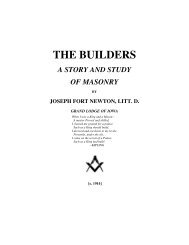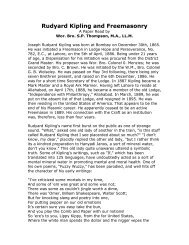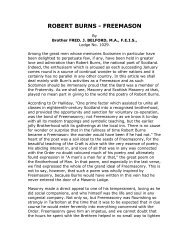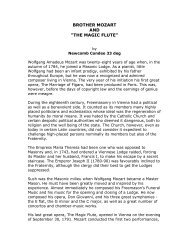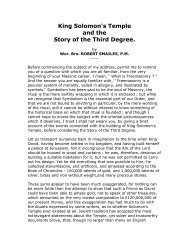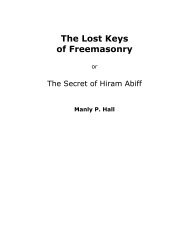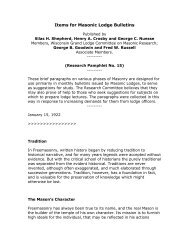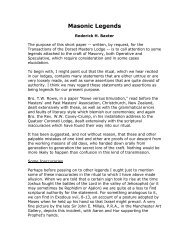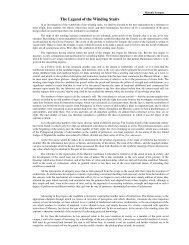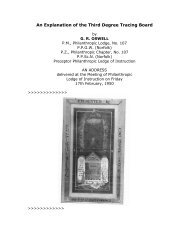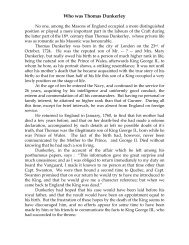Create successful ePaper yourself
Turn your PDF publications into a flip-book with our unique Google optimized e-Paper software.
<strong>THE</strong> MASON’S <strong>APRON</strong><br />
by<br />
William Harvey, J.P.<br />
Fellow of the Society of Antiquaries of Scotland;<br />
Ex-Pres Dundee and District R.W.M.’s and P.M.’s Assn.;<br />
Provincial Grand Bard of Forfarshire; M.M. Stirling Royal<br />
Arch, No. 76; Hon. Mem. Caledonian Dundee, No. 254; R.W.M.<br />
Progress Dundee, No. 967, 1914-1916; Charter Mem. Dundee St<br />
Mary No. 1149; P.W. Sub. M. Ubique, Dundee, No. 1192;<br />
Hon Mem, No. 6, R.A.; Hon. Mem. No. 416 R.A.; Founder<br />
and First Principal No. 421 R.A.; Hon. Mem. No. 423 R.A.;<br />
Founder No. 449 R.A.<br />
Dundee:<br />
T.M. Sparks, Crosswell Works<br />
- - - - - - -<br />
1921
PREFACE<br />
The Masonic Apron, as the badge common to all the brotherhood, has<br />
much to inspire reflection, and in the following pages I have brought<br />
together one or two thoughts upon the subject in the hope that they<br />
may be of use to members of the Craft.<br />
William Harvey<br />
4 Gowrie Street<br />
Dundee<br />
<strong>THE</strong> MASON’S <strong>APRON</strong><br />
Probably the earliest moment at which a candidate for Freemasonry<br />
recognises that he is really and truly a brother of the Craft is when the<br />
W.S.W. approaches him and in the name of the G.A.O.T.U., and by<br />
command of the R.W.M. invests him with the distinguishing badge of a<br />
Freemason. Whatever other information as to the Fraternity he may<br />
have gleaned from the outer world, he has certainly learned that<br />
Freemasons clothe themselves with aprons, and now when one of<br />
these articles of attire is girt about his waist he must realise that he is<br />
really within the pale of the brotherhood. The charge that follows the<br />
investiture — whether it be the simple dignified little address that<br />
reads like a passage from Holy Writ or the more elaborate appeal<br />
which draws its colour from the honours of Masonry and the jewels of<br />
the Eastern potentate — cannot fail to impress him with the fact that<br />
the Fraternity looks upon the apron as a badge neither to be lightly<br />
conferred not to be worn with indifference.<br />
As the apron is common to all the Degrees so it may be said with<br />
perfect truth that it is the most comprehensive symbol of our faith as<br />
well as the clearest evidence of our long descent. In a very material<br />
way it links us to those operative masons with whom we claim the<br />
closest kinship, and to whom we look as our immediate ancestors, but<br />
when it is invested with the attributes of innocence and purity it<br />
connects us in a community of thought and aspiration with the
followers of every religion and the expounders of every moral system<br />
that has sought to elevate mankind.<br />
The initiate is told that the badge is more ancient than the Golden<br />
Fleece or the Roman Eagle. Indeed, it is probably the oldest article of<br />
clothing in the world, and there is general agreement in the view that<br />
it was devised to preserve just that purity and innocence of which the<br />
Freemason regards is as an emblem. Out first parents in their earliest<br />
act of self-conscious pride wove fig leaves together to cover their<br />
nakedness, and this desire to veil the <strong>org</strong>ans of creation is found as a<br />
natural instinct even among savage races. The grass skirt of the South<br />
Sea Islanders, the body cloths of the natives of India and Africa, and<br />
the conventional attire of civilised peoples may all be traced to this one<br />
primal instinct that it is good that a sense of innocence should be<br />
preserved.<br />
It may have been just bec<strong>au</strong>se of this moral significance that the<br />
apron was imported into religion and became one of the vestments of<br />
the priesthood. It is found as an article of the accepted dress of the<br />
priests of the Jewish faith, as well as of the officials of many other<br />
religions. The suggestion has been made that the apron is allied to the<br />
girdle of the prophets — the girdle of Elijah in the Old Testament, and<br />
the girdle of John the Baptist in the New. Both of these were of leather<br />
while is is also recorded that, on one occasion, Isaiah wore a girdle of<br />
hair-cloth, and that, on another occasion, Jeremiah donned one of<br />
linen. And it may have been that the priests borrowed the idea from<br />
the garments of the gods. Dr. Albert G. Mackey tells us in his “Lexicon<br />
of Freemasonry” that all the ancient statues of the heathen gods which<br />
have been unearthed in Greece, and Asia, and American are decorated<br />
with superb aprons.<br />
If the Masonic apron is derived from early ecclesiastical clothing so<br />
also is its prevailing colour. We read in the Book of Revelation that<br />
which is an emblem of purity and thus has it been esteemed in all<br />
ages. The Arch-Druid clothed himself in white ere he cut the sacred<br />
mistletoe; the priest of the Roman gods wore a vestment of white<br />
during the hour of sacrifice, and the priests of the Hebrew people wore<br />
ephods of white while engaged in the service of the sanctuary. These<br />
varying faiths met on the one common ground of making the white<br />
garment a symbol of the need that men should be pure in heart if they<br />
would enter into the presence of God.<br />
Those Masonic students who like to trace all our Speculative system to<br />
the work of our Operative brethren say that as the Craftsman wore an
apron to save his clothing from being soiled at work, so the<br />
Speculative brother dons it as a symbol of his desire to be kept<br />
unspotted from the world. But is has a longer lineage and a closer<br />
affinity with moral and spiritual purity than anything that can be drawn<br />
from the leather apron of the humble worker with mallet and chisel.<br />
Down through the ages a white garment has been the distinguishing<br />
feature of initiation. In the mysteries of Mithras in Persia the candidate<br />
was invested with a white apron, as he also was in certain Japanese<br />
initiations. The garment of initiation in Greece was of the same hue,<br />
bec<strong>au</strong>se, says Cicero, white is a colour most acceptable to the gods. As<br />
an emblem of holiness, the Essenians arrayed their postulant in a<br />
white robe which was bordered with a fringe of blue ribbon, and it may<br />
be a survival of this border that we have in the blue binding of some of<br />
our “working” aprons. If we pass from heathen to Christian practice we<br />
find the same colour in evidence. It was customary in the primitive<br />
Christian Church for baptised converts to be impressively clothed with<br />
a white garment, and in that vision of the Grand Lodge above<br />
vouchsafed to the Apostle John at Patmos, we are told that there was<br />
“a great multitude, which no man could number, out of every nation,<br />
and of all tribes and peoples and tongues, standing before the throne<br />
and before the Lamb, arrayed in white aprons.”<br />
I have said the apron is the most comprehensive symbol of our faith,<br />
and if, on the one hand it is derived from the garment which the<br />
Divine Creator bestowed upon fallen man in Eden, and on the other is<br />
an emblem of the robes of Paradise that have been washed and made<br />
white in the blood of the Lamb, then surely it is the fitting badge of the<br />
whole human race in their age-long march from darkness unto light!<br />
And as that march of the whole creation is epitomised in the life of<br />
every individual it is fitting that the apron should be presented to the<br />
young Mason in the First Degree since his admission into the Craft in a<br />
state of helpless indigence is an emblematical representation of the<br />
entrance of all men on their mortal existence.<br />
The Masonic Apron worn by the Initiate like everything else in our<br />
elaborate ceremonial, must conform to certain standards. It should be<br />
of pure white lambskin from fourteen to sixteen inches wide, and from<br />
twelve to fourteen inches deep with either a semi-circular or a<br />
triangular flap which falls to about four inches at its greatest depth.<br />
Often it is embellished with the name and number of the Lodge, but it<br />
should be without ornament of any kind. The yong Mason, accepting<br />
the plain undecorated apron as his chart, may trace upon it his upward<br />
career in the craft. When he reaches the Second Degree he may
embellish it with two rosettes at the bottom, and when he becomes a<br />
Master Mason he may add a third rosette, line and edge it with silk of<br />
that colour adopted by his Lodge, and further adorn it by adding<br />
tassels. The origin of tassels and rosettes has given rise to<br />
considerable discussion. It has been suggested that the tassels have<br />
been evolved from the two long ribbons by which early aprons were<br />
girt about the body. These ribbons passed round the waist and were<br />
tied under the flap, with the ends pendant in front. The ends were<br />
ornamented with a silver fringe, and had become so characteristic<br />
that, when the strap and buckle arrangement was devised, they were<br />
retained, being gathered up into the form of tassels and placed one on<br />
either side. No satisfactory explanation of the origin of rosettes has<br />
been furnished. One theory is that they represent the point within the<br />
circle with which all Freemasons are familiar, but it is not generally<br />
accepted. Other details, always in the way of more elaborate<br />
decoration, are added according to the taste of the wearer. Sometimes<br />
the rosette bears a five-pointed star in relief. Occasionally the flap is<br />
embellished with the compasses and square and the sacred symbol in<br />
the centre. Now and again we find it ornamented with the Sun, the<br />
Moon, the Seven Stars, and the All-Seeing Eye. There does not appear<br />
to be any limit to the scheme of decoration which a brother may adopt<br />
so long as he confines himself to purely Masonic symbols. Office, of<br />
course, carried with it, its own ornaments. The apron of every officebearer<br />
should display the particular jewel of his office; and in the case<br />
of a R.W.M. or P.M. the two rosettes at the bottom are replaced with<br />
levels of inverted “T<strong>au</strong>s” while the rosette on the flap gives way to the<br />
compasses and square enclosing the Sun and resting upon the<br />
segment of a circle, all which denote the rank of the brother.<br />
But, no matter what the decoration or the rank it denotes every<br />
brother — even the Grand Master upon whose honoured shoulders<br />
rests the purple of the fraternity — must bear in mind that no<br />
adornment can add anything to the moral grandeur of the symbol, and<br />
that the badge of a Mason is found not in fine gold nor in silken fabric,<br />
but in the pure and spotless surface of the lambskin which is the<br />
common mark — as it should be the common object of veneration —<br />
of every member of our ancient and honourable fraternity.<br />
The thoughtful Freemason who lingers over the charge which is<br />
addressed to him at his investiture cannot fail to appreciate that the<br />
apron is an emblem of all that is highest and best in human life. Bro.<br />
W. Harry Rylands, in an article on “The Masonic Apron,” which he<br />
contributed to the “Transactions of the Lodge Quatuor Coronati,” says<br />
that he has found nothing which would lead him to believe that much
of the symbolism of the Freemason’s apron which is commonly<br />
received at the present time is of very early date. He inclines to the<br />
view that it may have come in when the newer symbolism was<br />
introduced as otherwise it would be difficult to account for so many<br />
aprons being made of silk, velvet, satin, cloth, canvas and even<br />
chamois-leather, which he suggests, with a touch of subtle humour,<br />
might be called “the skin of the goat!” But while lambskin and the<br />
moral teaching deduced therefrom may belong to modern<br />
Freemasonry, Dr. Oliver tells us that in ancient days the apron or<br />
girdle of whatever material composed was universally received as a<br />
symbol of Truth and all nations have ever regarded Truth as serenely<br />
throned upon a mountain high above the strife and turmoil of men and<br />
the warrings of races. Locke, the <strong>au</strong>thor of “The Human<br />
Understanding”, writing to Anthony Collins, says, “to love truth for<br />
truth’s sake is the principal part of human perfection in this world, and<br />
the seed-plot of all other virtues.” We are told that the Apron is the<br />
badge of Innocence and the bond of Friendship. What is Innocence but<br />
the kindly smile on the face of Truth? And there cannot be any<br />
Friendship worthy of the name either between men or between nations<br />
that has not Truth as its one and only foundation. Friendship based<br />
upon anything else is but an Apple of Sodom — fair to look upon and<br />
false when put to the test.<br />
In addition to being the badge of Innocence and the bond of<br />
Friendship, the apron is an ever-present reminder of that purity of life<br />
and action which should at all times characterise a Freemason. The<br />
outer world, bec<strong>au</strong>se it does not know us, regards us with rather<br />
dubious eyes. We are constantly wrapt about with an air of mystery<br />
and occasionally invested with an unworthy tradition; and if we were<br />
to seek to persuade the uninitiated that our mission was the uplifting<br />
of humanity they might smile in derision, and point a mocking finger.<br />
These things need not c<strong>au</strong>se us to blush for the badge we don, nor<br />
deter us from our work in raising the Temple of character. Our legends<br />
tell us that the Master Architect was slain by men who could not<br />
appreciate the value of Truth and Honour, and the greatest Builder the<br />
world has ever seen was crucified at the behest of a mob who were<br />
blind to His great purpose. But the presence of three unworthy<br />
workmen at the Temple detracts in no way from the grandeur of the<br />
House which Solomon raised to Jehovah; just as the treachery of<br />
Judas, the denial of Peter, of the desertion of John in the Galilean<br />
drama dims not the glory of the sacrifice on Calvary. So if, in building<br />
the great temple of brotherhood, we meet with Masons who are not<br />
always true to their great ideals, that is no reflection upon the work to<br />
which we are called and no justification for the sneer and contempt
with which many people, in their ignorance, regard Freemasonry. At<br />
the same time it is obvious that, if we would be true to the emblem<br />
which is our earliest tangible possession as Craftsmen, we must<br />
convince the world by exemplary conduct that merit is our title to the<br />
privileges we enjoy.<br />
The Apron has inspired many, more or less indifferent poets to sing its<br />
praises, and, generally speaking , the effusions, like almost all Masonic<br />
verse, have hardly been worth the paper upon which they were<br />
printed. I came across some stanzas the other day entitled, “The<br />
White Leather Apron,” and while the poem as a whole was neither<br />
better nor worse than the generality of such things, I thought there<br />
was one quatrain that struck a rather inspiring note. After dwelling<br />
upon the fact that the badge was more ancient than the Golden Fleece<br />
and more powerful than the Field-Marshal’s baton, the poet<br />
proceeded:--<br />
‘Tis the shield of the orphan, the empblem of love,<br />
‘Tis the charter of faith from the Grand Lodge above;<br />
While the high and the low, in its witeness arrayed,<br />
Of one blood and one kin by its magic is made.<br />
When first invested with it we are conjured to let its pure and spotless<br />
surface be to us an ever-present reminder of rectitude of life and<br />
purity of conduct; and a never failing argument for higher thoughts,<br />
nobler deeds, and greater achievements. What is all this but an appeal<br />
to the best that is in us to make this world a better place for ourselves<br />
and our fellow-men? The Freemason knows no party in politics nor<br />
does he confess any creed in religion, for, in theory as a member of a<br />
community, and in practice as an individual, he is willing to avail<br />
himself of whatever he can find in any party, and in every faith that<br />
tends to the uplifting of humanity. He takes the Temple of King<br />
Solomon as a symbol of that Temple of Ideals to the building of which<br />
he is called, but he does so only bec<strong>au</strong>se he is a member of a<br />
brotherhood that has sought to give concrete form to its intangible<br />
design. Others are engaged in building the same Temple and are<br />
working with the same materials, for the stones are Truth, Honour,<br />
Friendship, and Purity, and the cement is Peace, Harmony, and<br />
Brotherly Love. It may be said, therefore, that all men are builders in a<br />
common c<strong>au</strong>se, and yet in a very special sense the work is individual.<br />
In the erection of the Temple of Character it is not what other men do<br />
that counts. Other men may lay their courses well and truly but their<br />
work will reflect no credit upon us when the Master Architect comes to<br />
compare what we have done with what we were given to do. And it is
just here that Freemasonry as an institution discharges its great<br />
function. By wealth of symbol and illustration it seeks to guide and<br />
direct its members in the paths of virtue and science, ever teaching<br />
them that the greatest happiness is found in doing good. “Any good<br />
deed that I can do,: wrote someone who would not have dishonoured<br />
Freemasonry, “or any kindness that I can show, let me do it now: let<br />
me not defer it or neglect it, for I shall not pass this way again.”<br />
Ant that is the thought that should be in the mind of every brother<br />
who would prove himself worthy to wear the badge that is consecrated<br />
to goodness and virtue by centuries of usage. He has worn the Apron<br />
in vain who has not learned that our ancient Fraternity exists to shed<br />
the light of love upon this darksome world. In the Third Degree we are<br />
t<strong>au</strong>ght that a day will come when the apron will be put off never again<br />
to be worn on this side of eternity, and as there will be no building to<br />
be done by us when it is “laid to rest beneath the silent clods of the<br />
valley,: it should be a constant reminder to us of the truth of the lines<br />
of Burns, our immortal bard and brother:--<br />
A few days may — a few years must --<br />
Repose us in the silent dust:<br />
The voice of Nature loudly cries,<br />
and many a message from the skies.<br />
That something is us never dies;<br />
That on this frail, uncertain state<br />
Hang matters of eternal weight;<br />
That future life in worlds unknown<br />
Must take its hue from this alone;<br />
Let us th’ important Now employ,<br />
And live as those who never die.



